Today, I’m sharing possibly the most classic Indian dish ever: Dal Tadka!
I grew up eating dal nearly everyday as a child (like many Indian kids!), and this version is my favorite weeknight dal recipe. It’s creamy, packed with layer upon layer of flavor, and is a warm hug in a bowl. It gets taken over the top with the spiced oil (tadka) and tastes like pure comfort food (but is healthy, vegan, and gluten-free).
And if you have my cookbook, The Vegan Instant Pot Cookbook, you can find a recipe for an easy but delicious Dal Tadka in Chapter 3.
What is Dal Tadka?
Dal = the Hindi word for lentil.
In India, dal refers not only to the dish but also to lentils themselves. The dish is basically a deeply spiced, aromatic lentil stew, but there are countless regional variations of dal and even more variations across each Indian family.
Tadka = tempered oil in which spices, herbs, and/or aromatics are briefly fried in oil. The name differs depending on the regional language. For instance, in Gujarati (the language my family speaks), we call it vaghar.
The dal (lentils cooked in spices and aromatics) is finished by pouring the tadka on top.
In this recipe, split lentils are cooked in a mixture of aromatics, ground spices, and tomatoes (which bring a pleasant tanginess) until soft and creamy. The lentils are finished with the fragrant tadka, which enhances both the taste and texture.

Why you’ll love this Dal Tadka
Pantry staples. Aside from a few aromatics (fresh ginger, green chili pepper, and cilantro), this is a pantry recipe!
Budget-friendly. In addition to being a pantry meal, it’s budget-friendly!
Authentic Indian food, restaurant-style. There are a ton of Indian recipes out on the internet, and a lot of them skimp on spices or just use one or two bottled spices. I can see the appeal of that, but if you want a truly authentic (and incredibly delicious) Indian dal, this is the recipe for you!
Comfort food but healthy. It’s creamy, deeply spiced and aromatic, and tastes indulgent. BUT, it’s made with wholesome ingredients and high in protein, thanks to lentils. Dairy-free, gluten-free, soy-free, and nut-free, so it’s allergen-friendly too!
What kind of lentils are used in dal?
Dal is typically made with split lentils or split peas, but there are also variations that use split chickpeas (“chana dal”) or kidney beans (“rajma dal”).
In this recipe, I use moong dal (AKA yellow split lentils), but growing up, my mom most often used toor dal (AKA yellow split pigeon peas). You can easily substitute with other split lentils. The cook time will vary, with the chana dal likely taking the longest, so you need to keep an eye on the dal as it cooks.
You can find every variety of split lentil and pea at South Asian grocery stores. If you have access to only a basic grocery store, use regular red lentils (they will take a bit longer to cook since their skins aren’t split).
You can also find these lentils on Amazon. All of these varieties work in this recipe.
- Moong Dal (yellow split lentils)
- Toor Dal (yellow split pigeon peas)
- Chana Dal (split chickpeas)
- Masoor Dal (red split lentils)
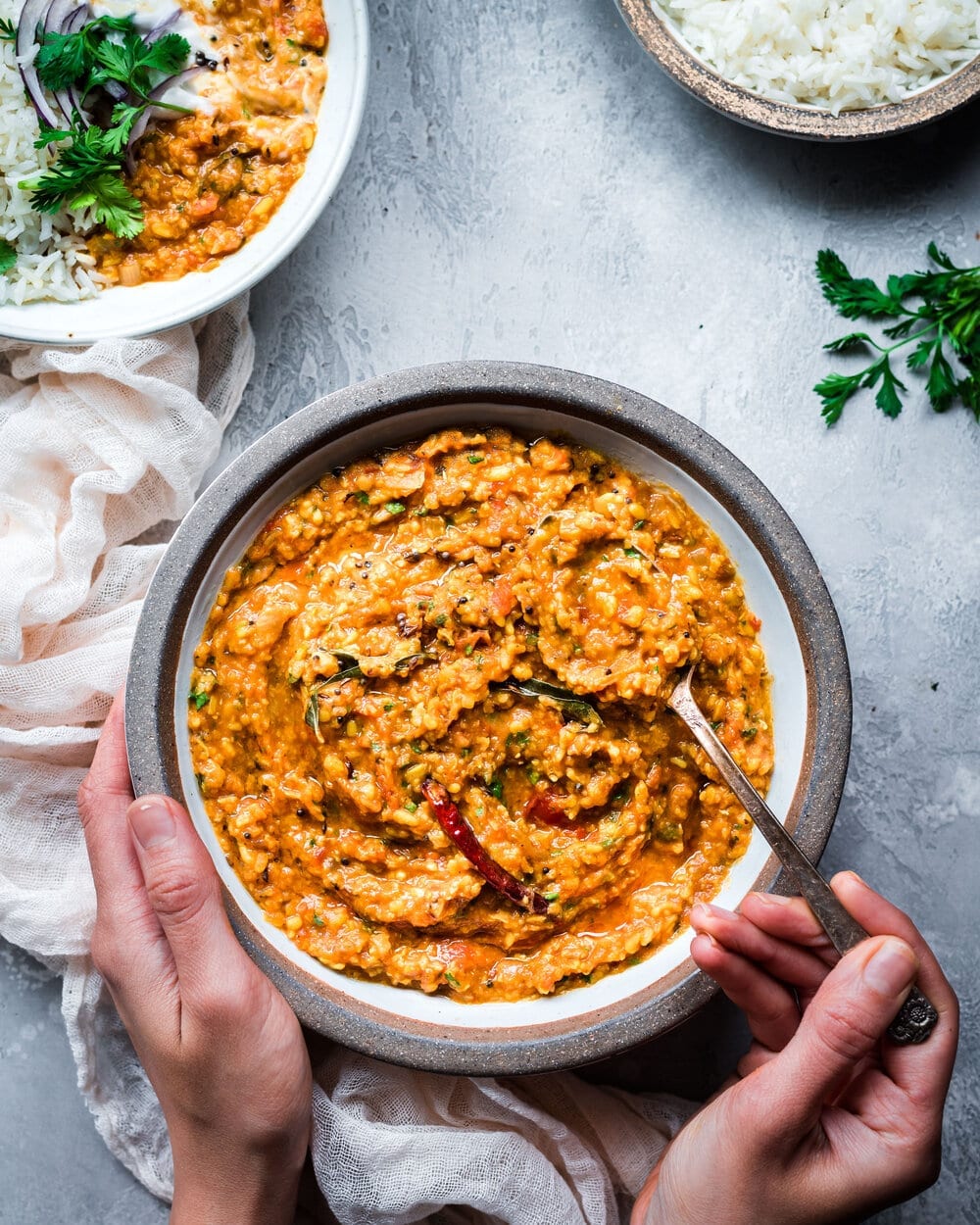
Everything you need to know about Tadka
Tadka is tempered and spice-infused oil, widely used in Indian cooking. The idea is to toast spices and aromatics in a fat source, as it releases their essential oils, which is where the aroma and flavors live.
Basic instructions for tadka
Heat up a few spoons of oil in a small pan (sometimes ghee is used, but I use oil to keep it vegan). Add whole spices and/or sliced or minced aromatics (like ginger or garlic). Toast them until they sizzle and become aromatic, swirling often to prevent burning.
If adding ground spices, add them last, for just 10-30 seconds. Stir or swirl the pan frequently to prevent burning.
Tip: The tadka brings SO much flavor and warmth to the dish (and even texture). It takes the dal from good to fantastic, so please please please don’t skip it!!
Tips for making tadka
An Indian spice tin is very handy. When you have to work quickly, it’s convenient to have all the spices in shallow, uncovered tins rather than in individual deep spice jars.
A small skillet works best, but a tadka pan is even better! It’s a tiny, deep saucepan that looks like a ladle and helps prevent the spices from jumping out of the pan.
Once your spices have released their fabulous aromas, take them off the heat immediately to prevent them from overcooking or burning.
What spices are used in tadka?
My version contains black mustard seeds, cumin seeds, curry leaves, and dried red chili pepper. I think the curry leaves and mustard seeds add the most flavor, so I wouldn’t skip those if you have an Indian grocery store near you. If you don’t, here are some dried curry leaves on Amazon.
Substitutes: If you don’t have all the spices in this recipe, fret not because every tadka is different. Here are some substitute options.
- Thinly sliced shallots or garlic
- Fennel seeds or fenugreek leaves
- Whole cinnamon sticks, broken into pieces
- Whole cardamom pods or whole cloves
- A few pinches of ground spices, such as cumin or coriander (be sure to add for just a few seconds at the very end to prevent burning)
- Asafoetida powder (aka hing) is often added to dal, as it helps the body better digest legumes. It brings all the spices together and makes it taste distinctly Indian. Note: it smells very pungent and offputting, but once cooked, its odor disappears.
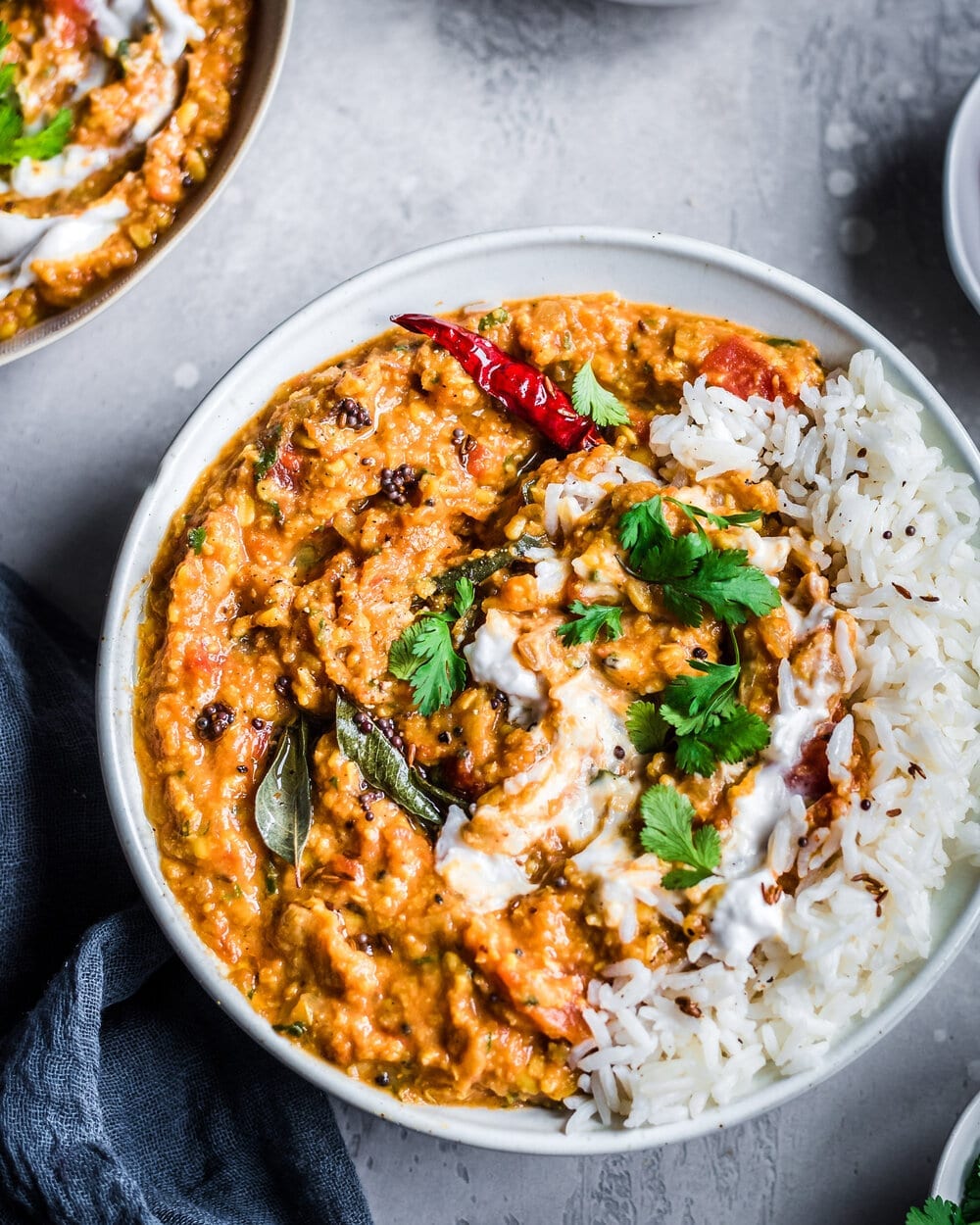
How to make Dal Tadka (step-by-step instructions)
Gather your ingredients.
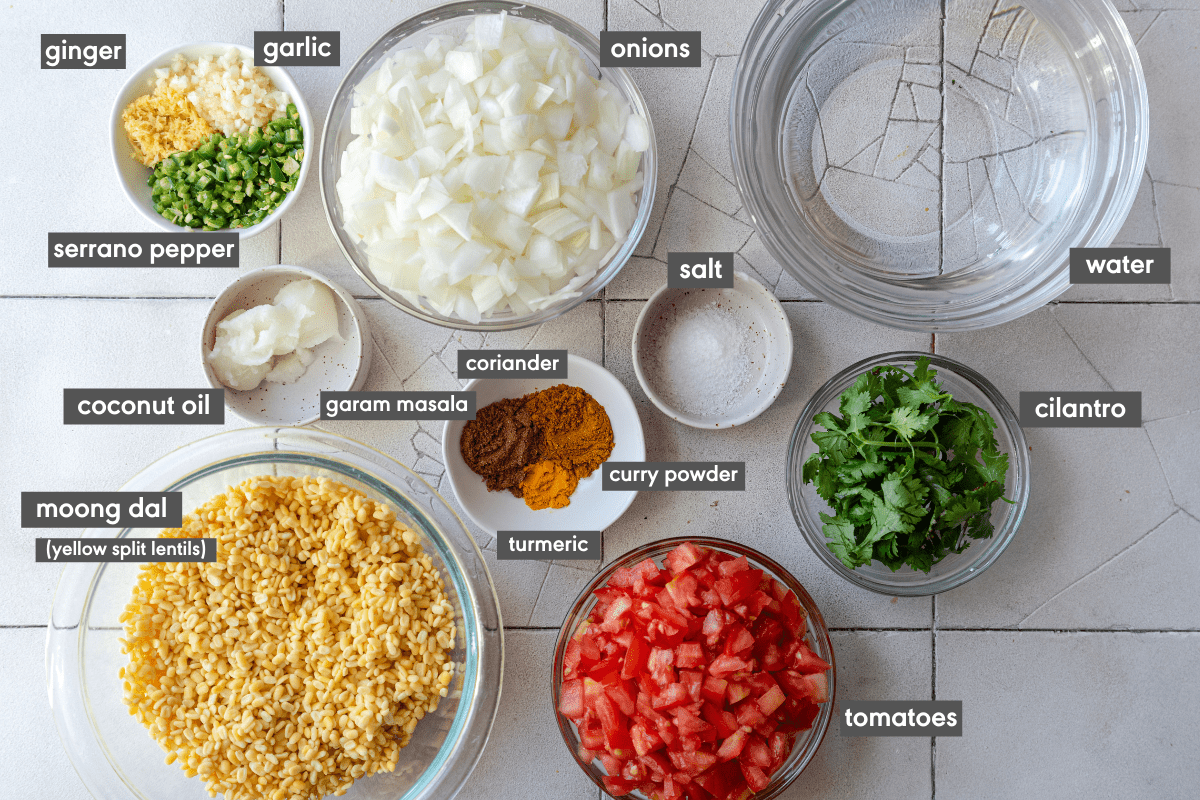
Heat a large frying pan over medium-high heat with the oil. Sauté the onions until starting to turn golden. Add the garlic, ginger and serrano pepper, and sauté for 60-90 seconds.
Add the ground spices and stir almost constantly for 30 seconds. Pour in 2 cups water to deglaze the pan, scraping up the browned bits.
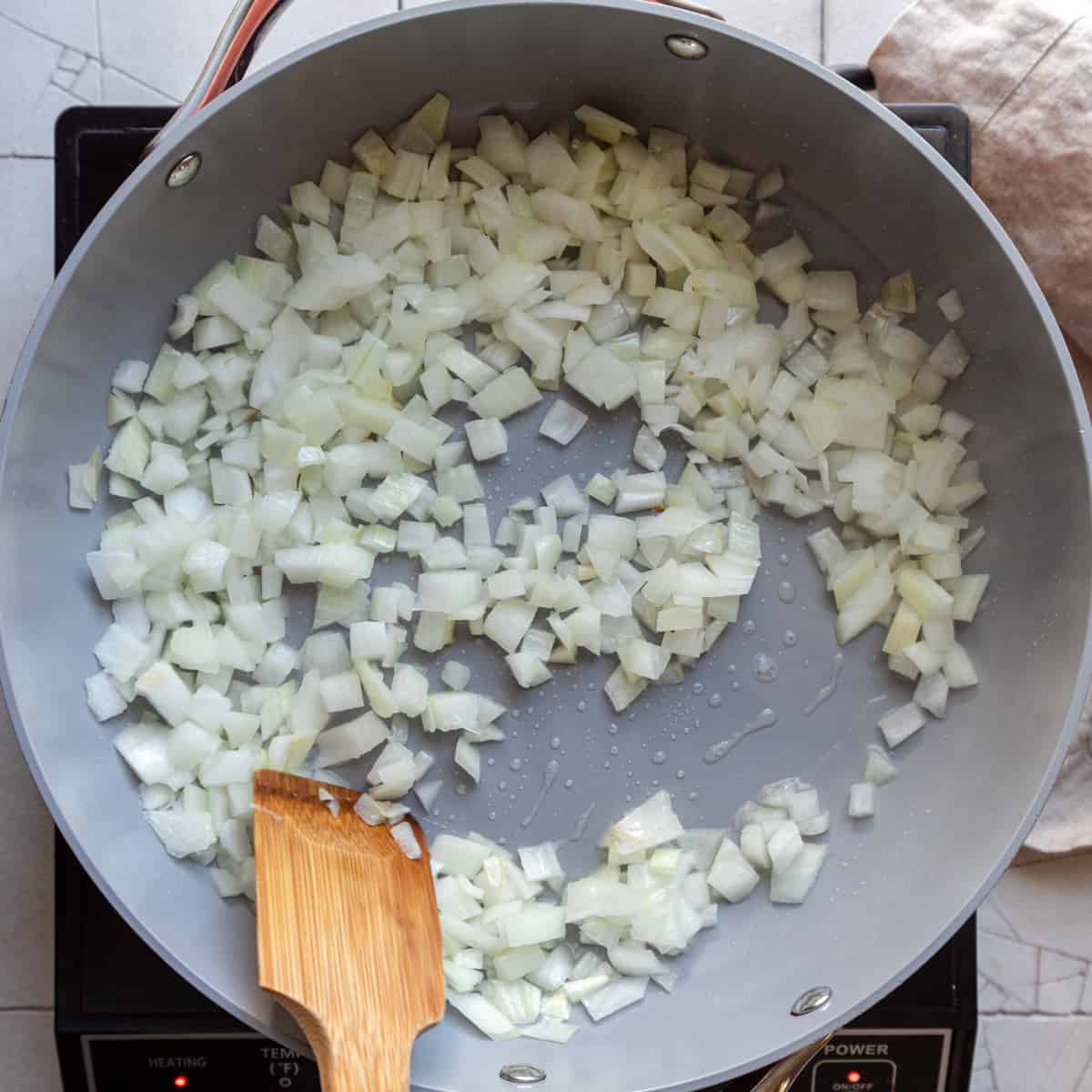
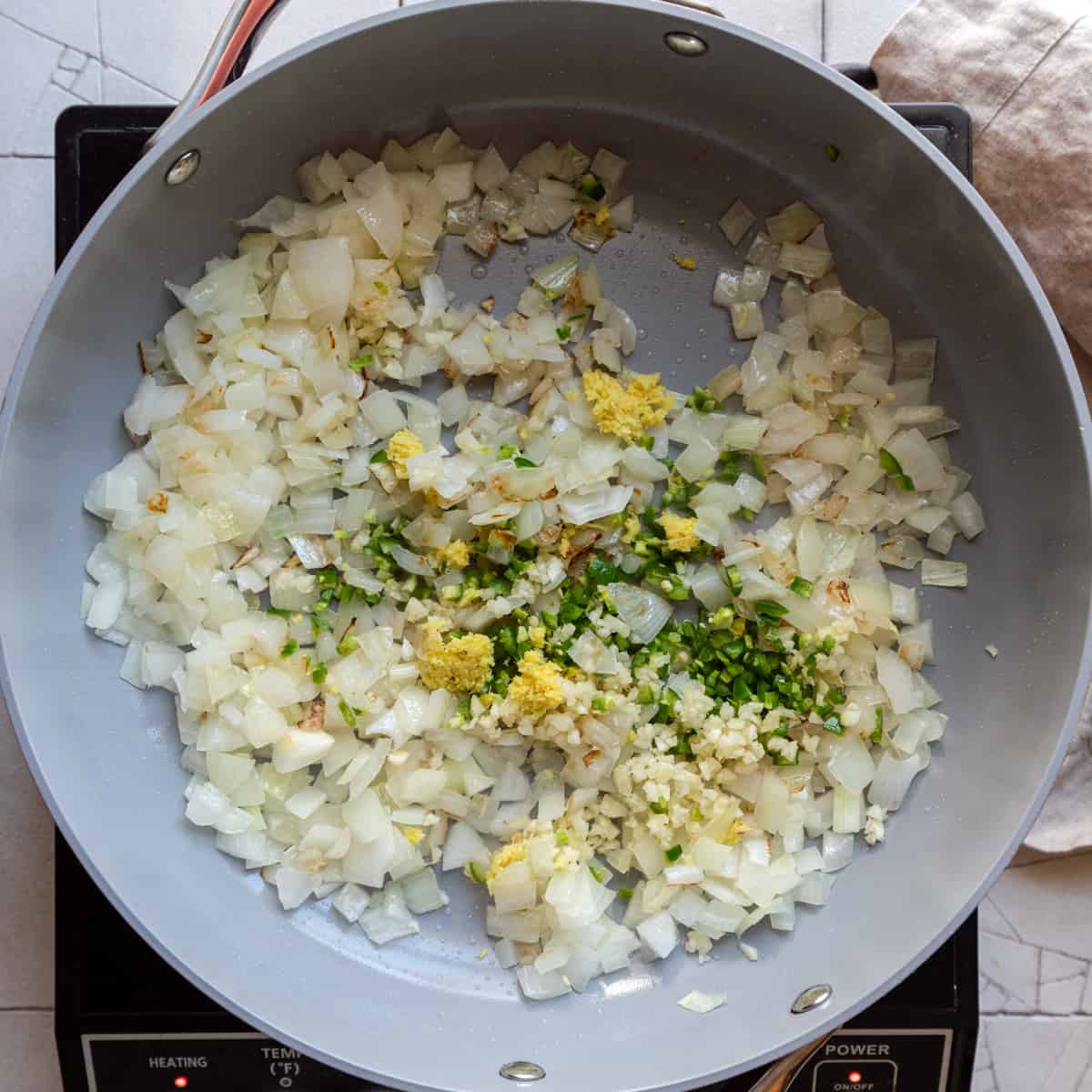
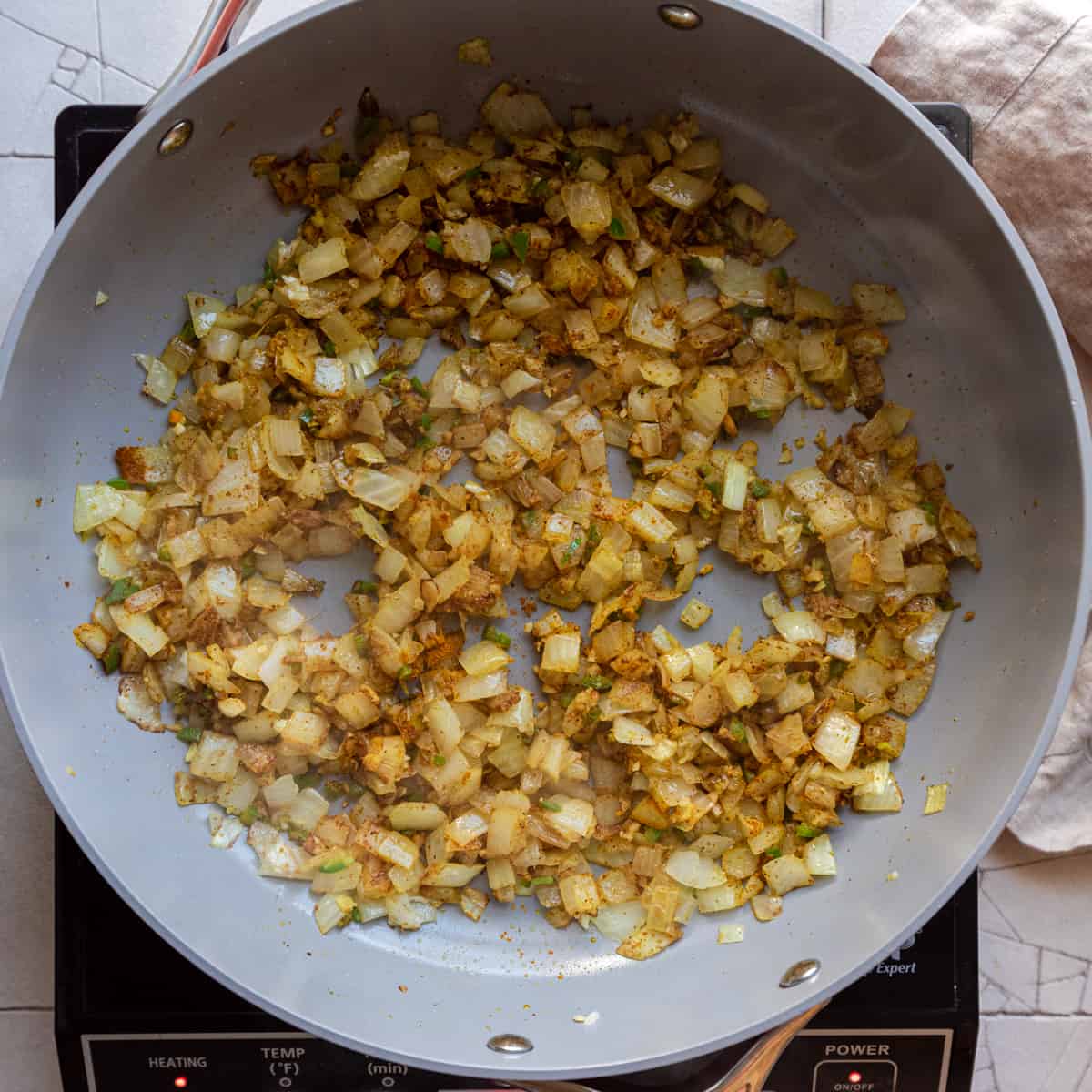
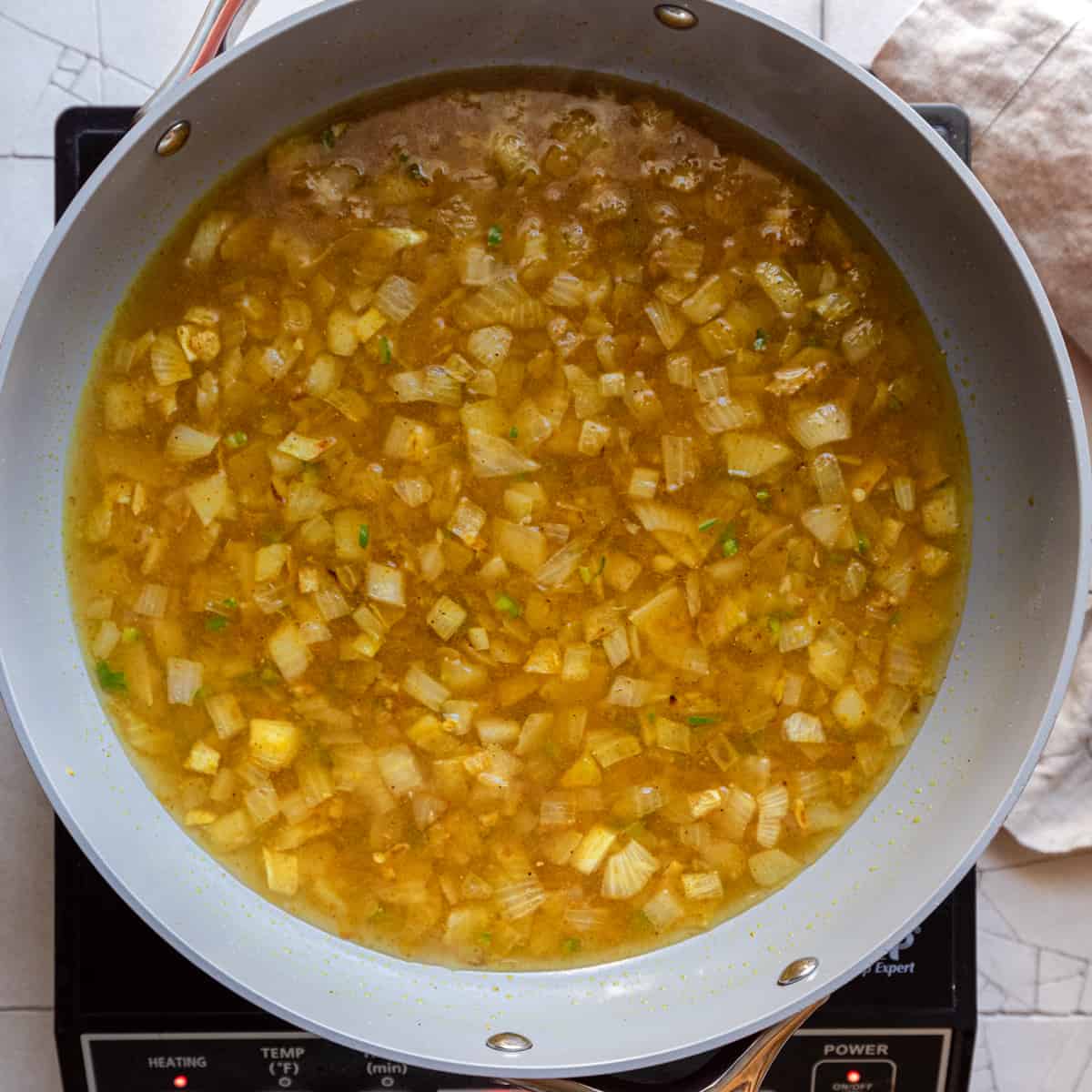
Add the lentils and salt/pepper to the pan. Bring the dal to a boil, then partially cover the pan and reduce the heat to maintain a simmer. Simmer for 30 minutes.
Add the diced tomatoes, stir, and cook uncovered for 4 to 5 minutes, until tomatoes are broken down (fresh tomatoes need more time). At the end, stir in the chopped cilantro.
Tip: for a creamier texture, run an immersion blender through some (but not all) of the dal.
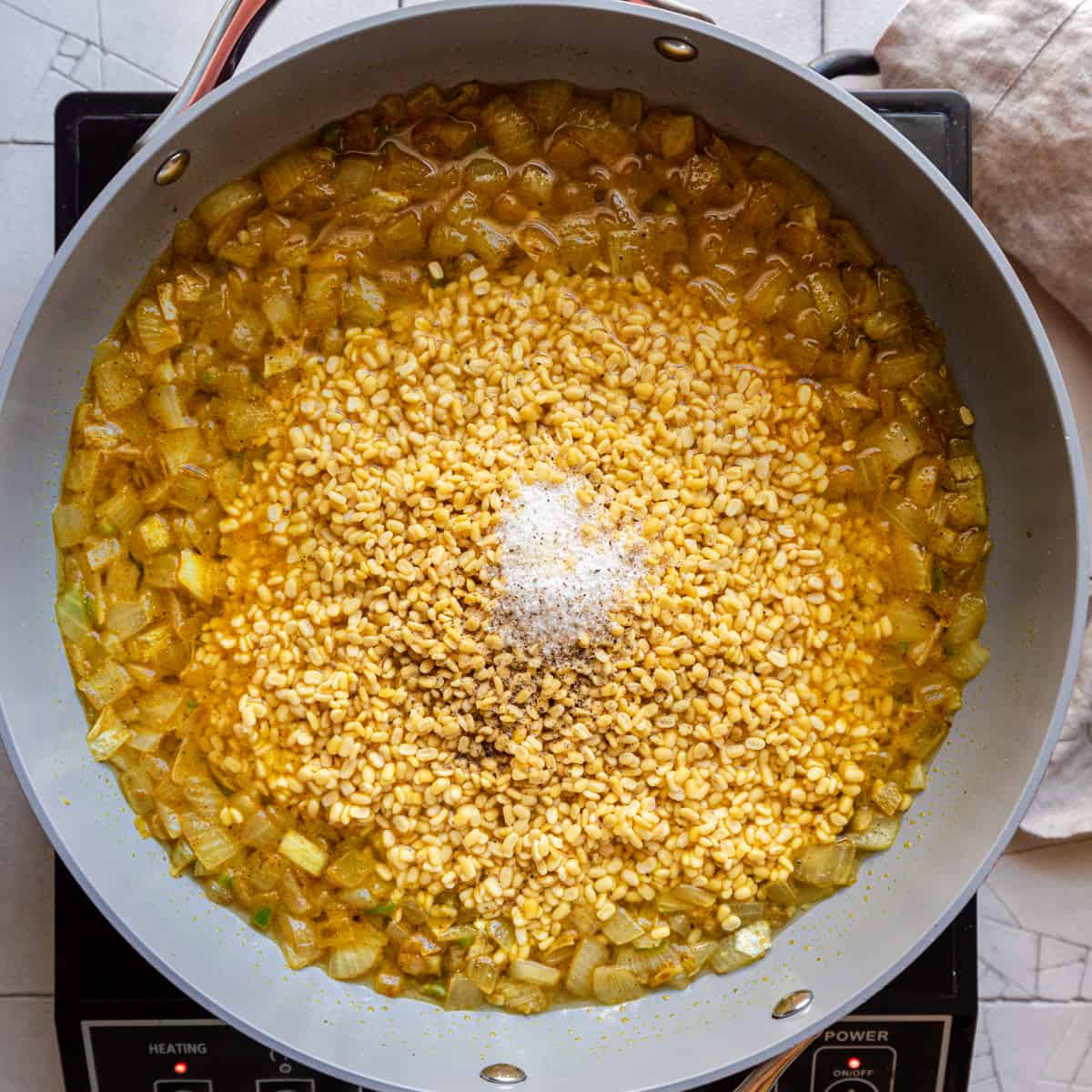
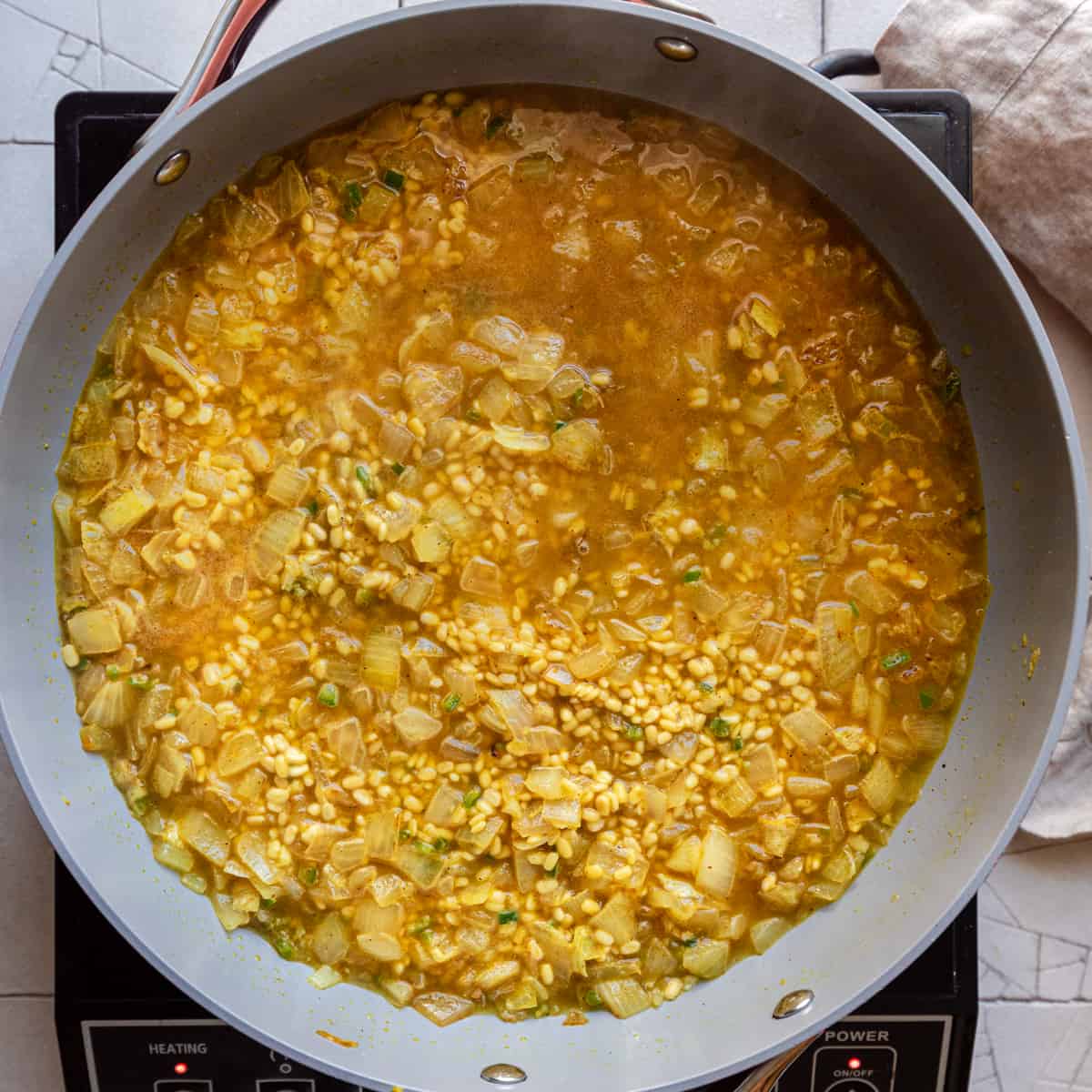
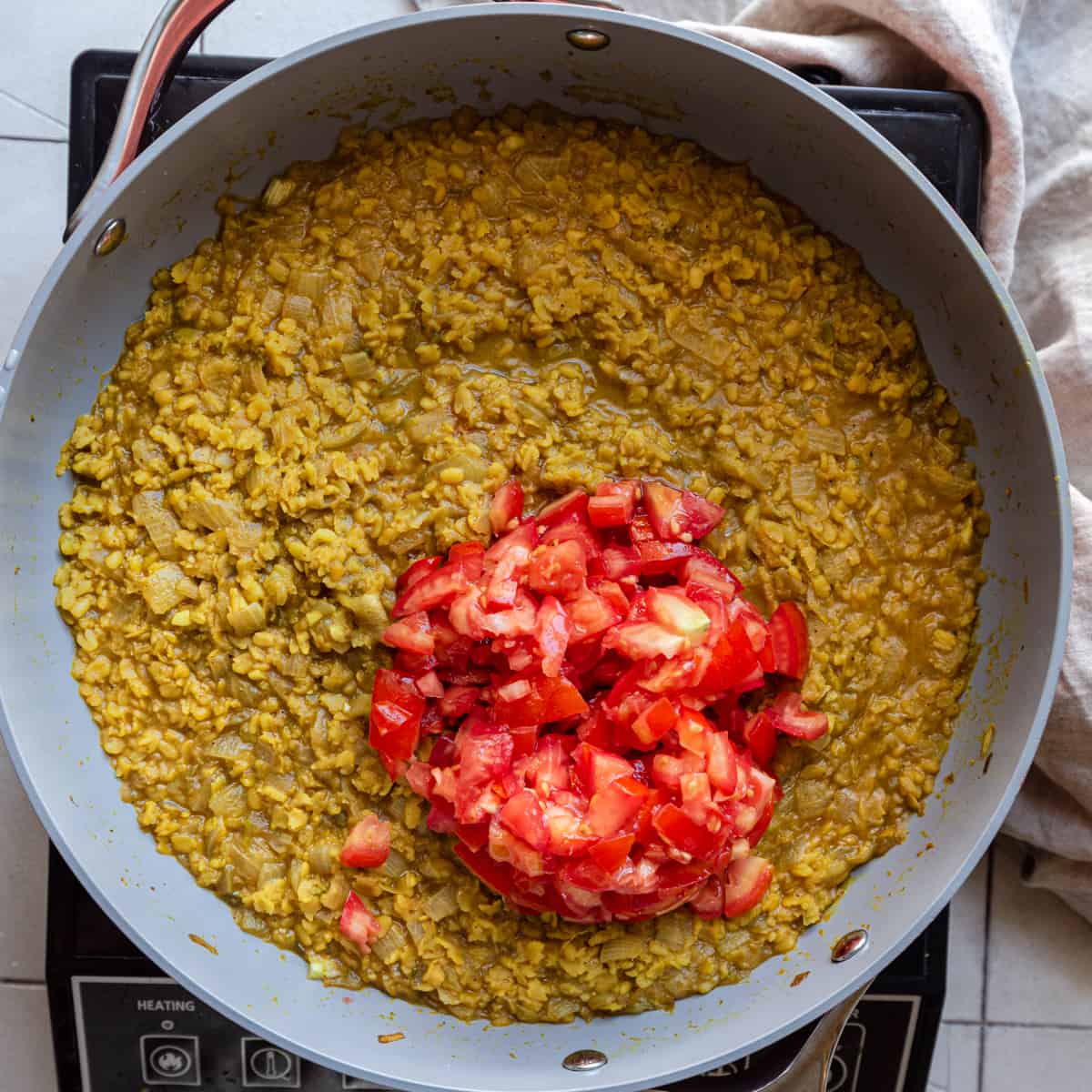
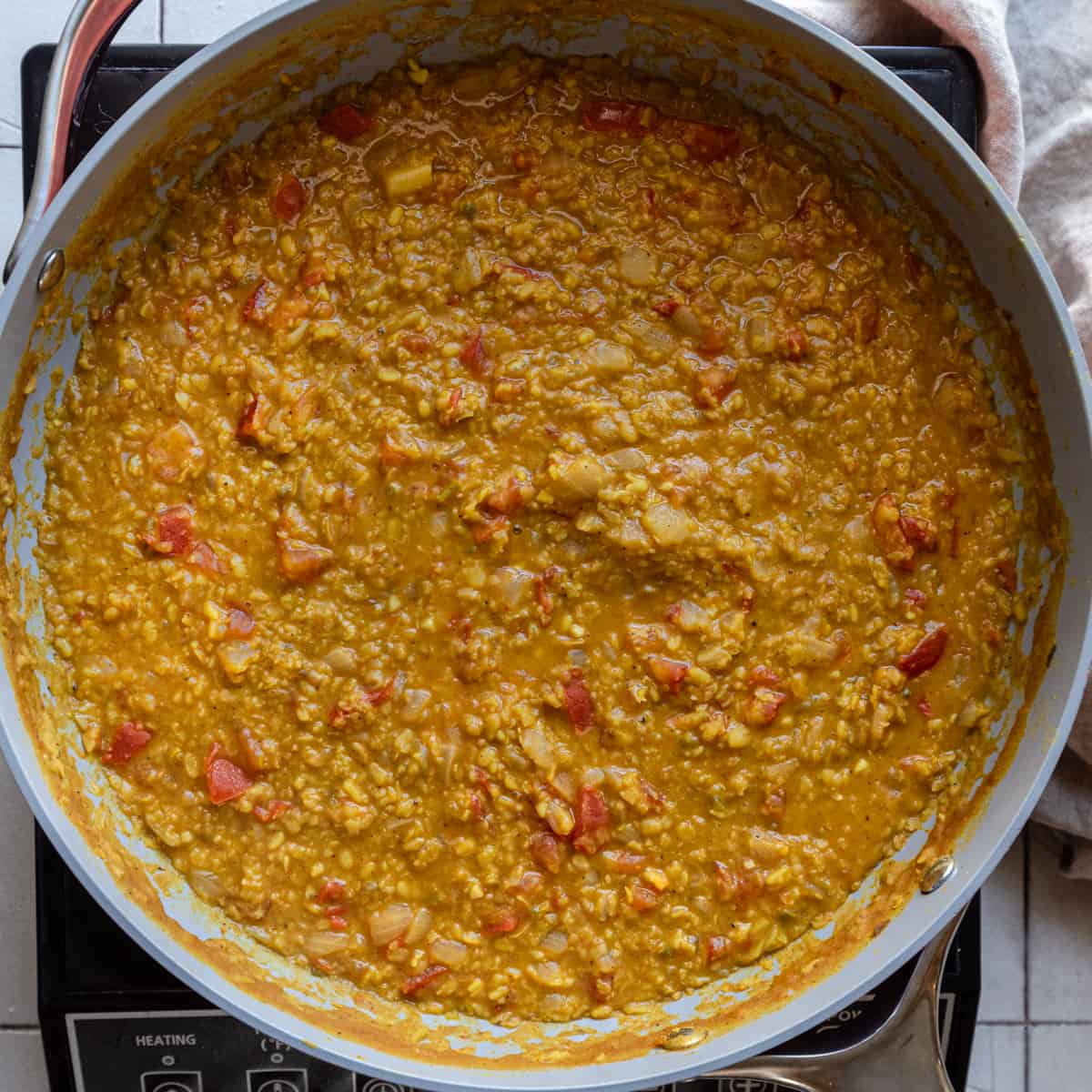
Before serving, make the tadka. Heat a couple spoons of oil up in a tadka pan or small skillet. Once shimmering, add the mustard seeds. Once they pop, add the cumin seeds. Finally, add the curry leaves and dried red chile peppers.
Keep stirring or shaking/swirling the pan to help cook the spices evenly and to prevent burning, for a total of 60-90 seconds.
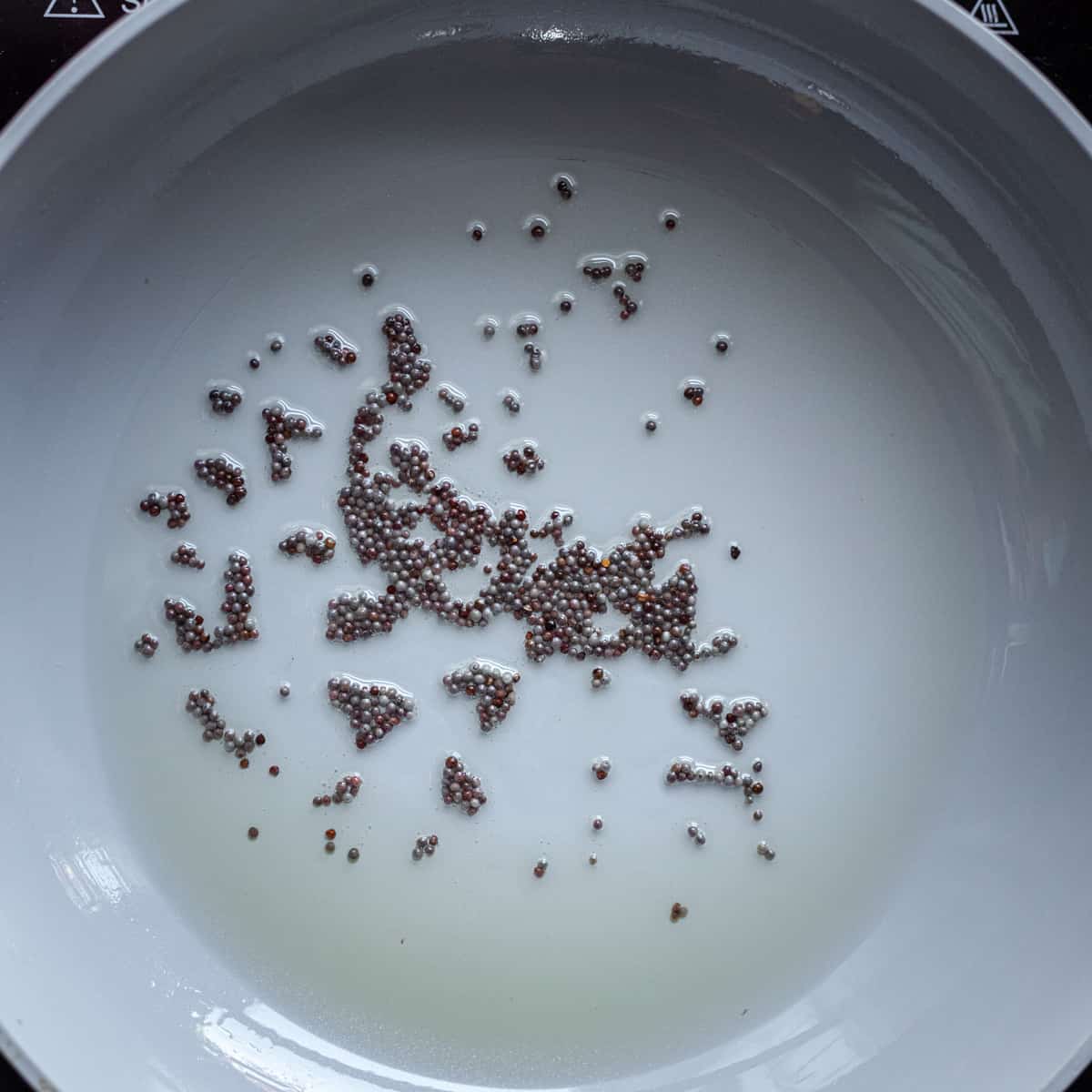
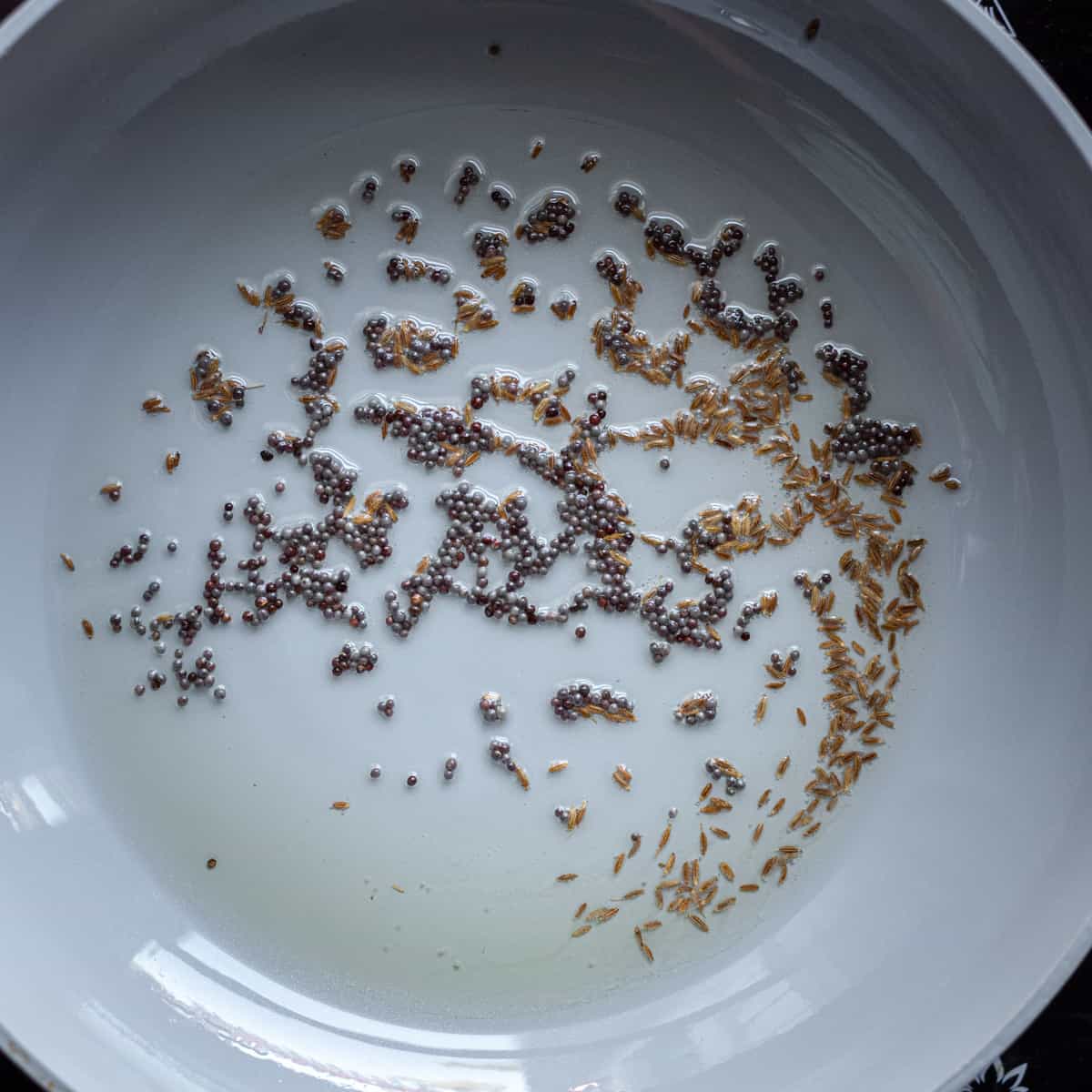
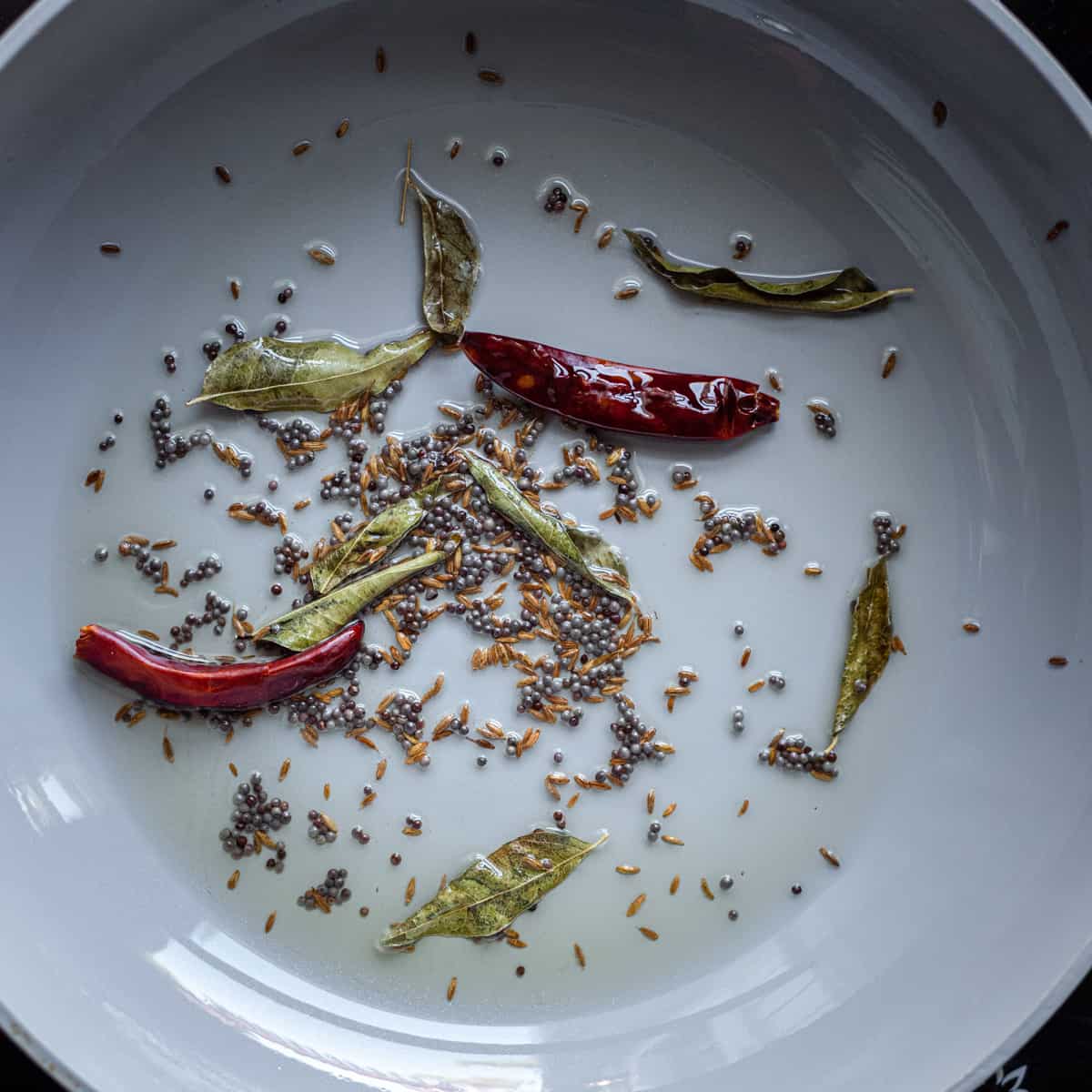
Pour the tadka over the dal and stir to incorporate. Garnish with more cilantro and serve warm!
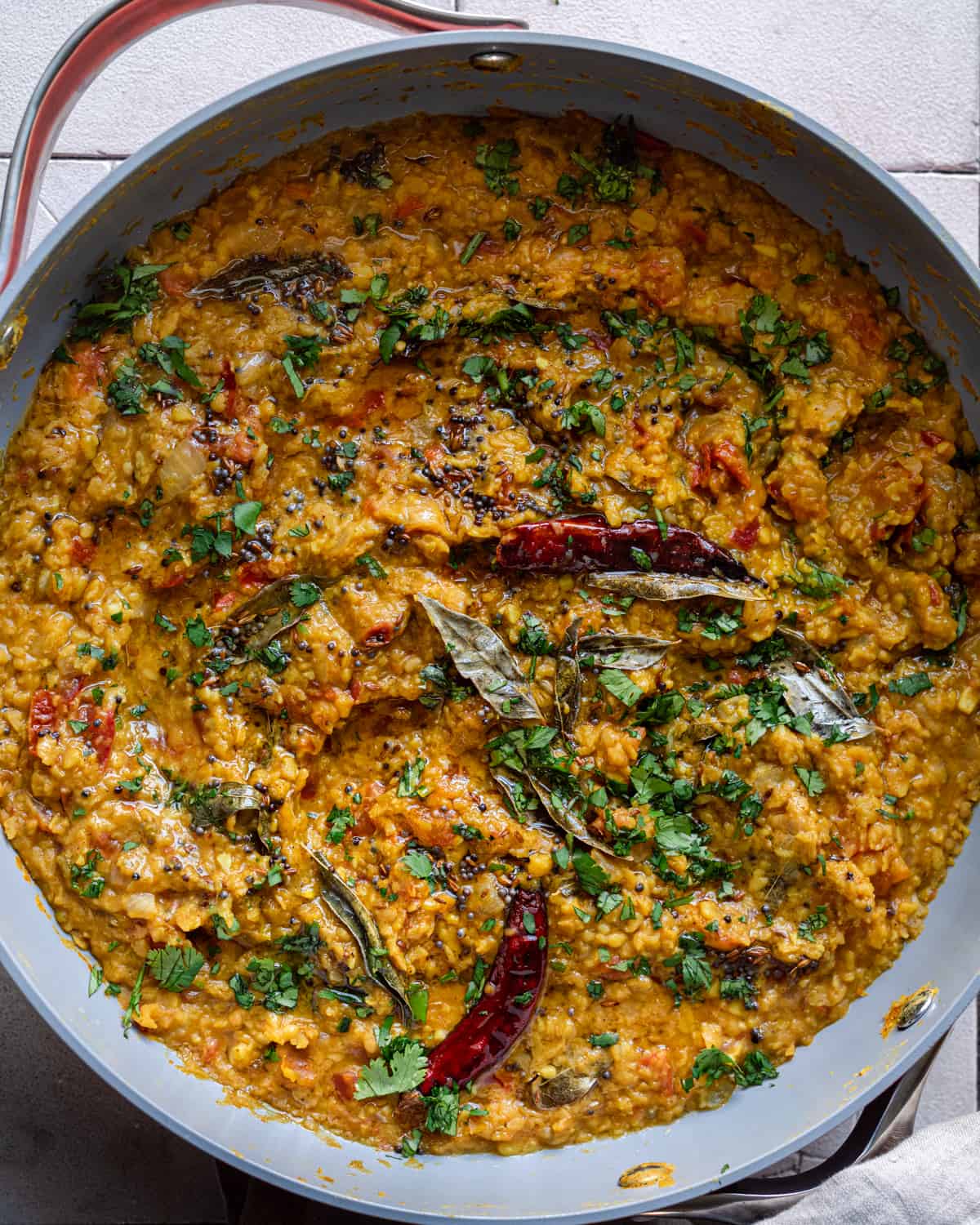
How to serve Dal Tadka
In most Indian families and restaurants, dal is served with either white rice or some sort of simple flatbread, like roti or chapati.
If you are feeling fancy, this dal pairs amazingly well with my homemade Vegan Naan recipe.
For toppings, I like to add a little coconut yogurt and thinly sliced red onion on top. If you don’t have vegan yogurt but still want something cooling, try a little diced avocado. Non-traditional but very good!
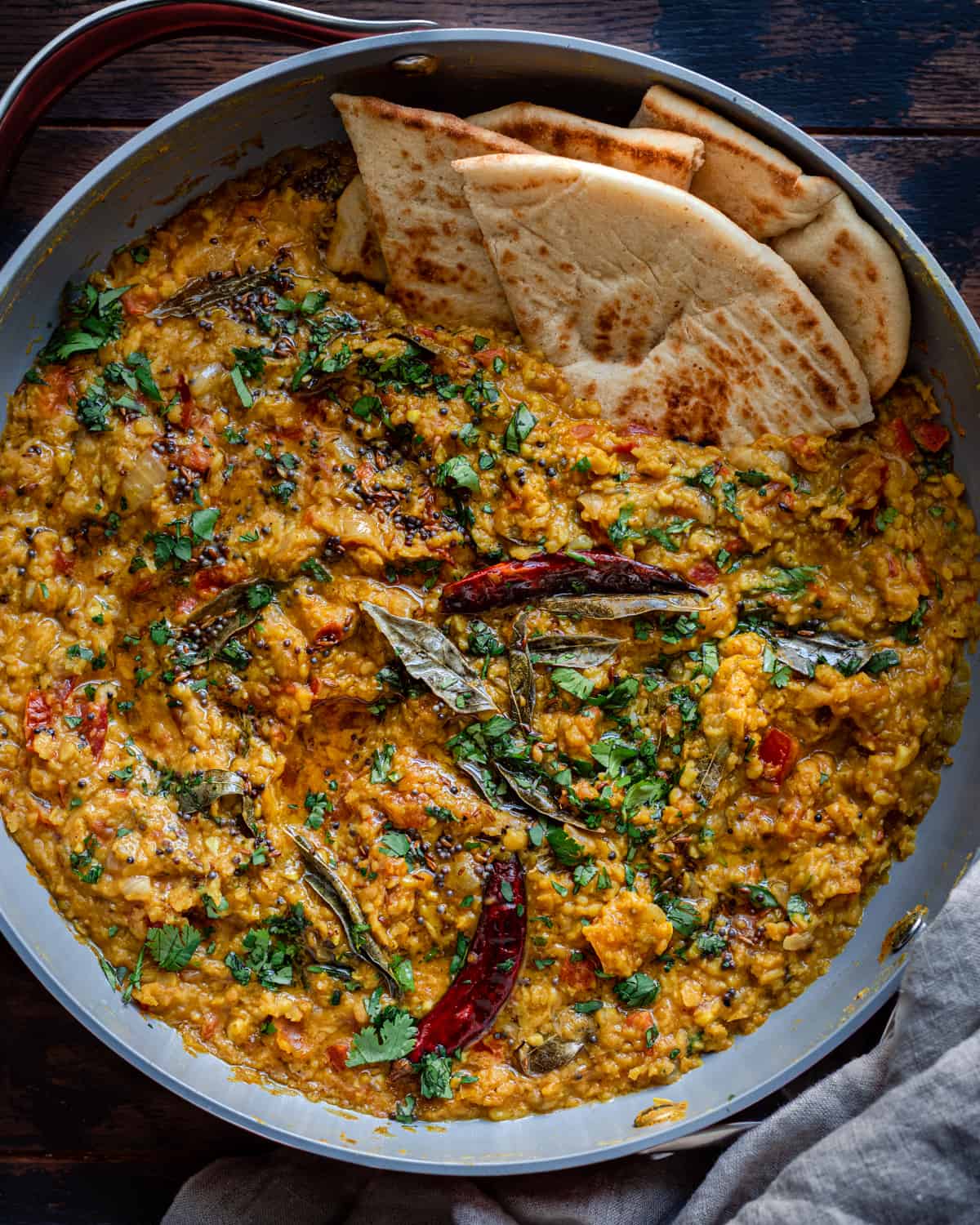
Watch! How to make Vegan Dal Tadka
In the above video, I show you how to make three different lentil recipes. For the Dal Tadka, fast forward to the 3:24 mark. And for more delicious recipe videos, check out my youtube channel!
If you love this recipe, be sure to tag me on Instagram with your recreations and please rate and review the recipe below!
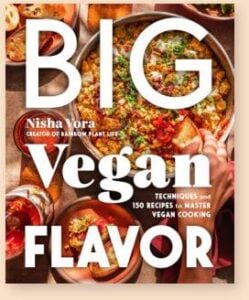
Big Vegan Flavor
Techniques and 150 recipes to master vegan cooking.
Restaurant-Style Dal Tadka
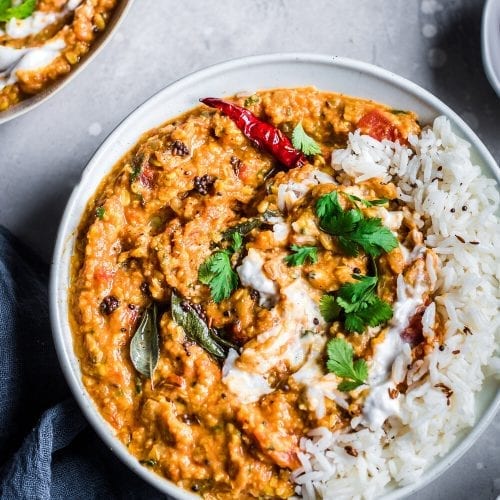
Ingredients
- 1 cup (200g) split yellow lentils, aka “moong dal”*
- 1 tablespoon coconut oil, or neutral oil of choice (more oil needed if not using a nonstick pan)
- 1 medium yellow onion, chopped
- 4 garlic cloves, minced
- 1- inch piece fresh ginger, grated or minced (about 1 tablespoon)
- 1 serrano pepper, diced (remove seeds & membranes for less heat)**
- 1 teaspoon curry powder
- 1 teaspoon garam masala
- 1/4 teaspoon ground coriander
- 1/4 teaspoon ground turmeric
- 2 1/2 – 3 1/2 cups (600 -840 mL) water***
- 1 teaspoon kosher salt, plus more to taste
- Black pepper to taste
- 1 (14.5-ounce / 410g) can diced tomatoes****
- 1 small handful of fresh cilantro, roughly chopped
Tadka
- 1 1/2 – 2 tablespoons coconut oil, or neutral oil of choice
- 1 teaspoon black mustard seeds, can substitute brown mustard seeds
- 1/2 teaspoon cumin seeds
- 5 to 10 fresh curry leaves (10 to 15 dried curry leaves)
- 1-2 dried red chile peppers (optional)
- 1 or 2 pinches asafetida (aka "hing") (optional)
Serving Options
- white basmati rice or Indian flatbread
- vegan coconut yogurt
- fresh cilantro and thinly sliced red onions
Instructions
- Sift through the lentils and remove any pebbles. Soak the lentils in cold water for 15 minutes and then drain them.
- Heat the coconut oil in a heavy, deep frying pan over medium-high heat. Once the oil is shimmering, add the onions and season with a pinch of salt, and cook for 5 to 7 minutes, until softened and starting to turn golden brown on the edges.
- Add the garlic, ginger and serrano pepper. Cook for 60-90 seconds, or until garlic is lightly browned and the mixture is very fragrant. Add the curry powder, garam masala, coriander, and turmeric and stir to coat into the onions, and cook for about 30 seconds, stirring almost constantly.
- Deglaze the pan with the water (I use about 2 cups at this stage), scraping up any browned bits on the bottom of the pan. Add the soaked and drained lentils, 1 teaspoon kosher salt, and black pepper to taste. Stir to combine.
- Bring the dal to a boil. Then lower the heat and partially cover the pan with a lid (if your lid has a small hole on top to allow steam to escape, you can fully cover the pan). Simmer the dal for 30 minutes, or until the lentils are fully cooked through, stirring occasionally and adding more water as needed to add adequate moisture/liquid to the dal.NOTE: Depending on your lentil variety, the cook time might vary from 25 to 35 minutes.
- Add the diced tomatoes and cook for 4-5 minutes, or until they’ve cooked down and are basically blended into the dal. If using fresh tomatoes, cook them until soft and broken down (fresh needs more time than canned). NOTE: If you want the dal to be thicker/creamier, run an immersion blender through some of the dal, but keep some lentils whole. It will also thicken more upon resting. Finally, stir in the chopped cilantro. Taste, adding more salt as needed.
- When the dal is done, make the tadka. Heat a small frying pan or tempering pan over medium heat on the stove. Add the 1 1/2 – 2 tablespoons of the coconut oil and, once it’s hot and shimmering, add the mustard seeds. Once the mustard seeds start popping (30 to 60 seconds), add the cumin seeds for a few seconds. Finally, add the curry leaves, dried red chile peppers (if using) and asafetida (if using). Keep stirring or shaking/swirling the pan to help cook the spices evenly and to prevent burning, 20 to 30 more seconds, or until very aromatic and the curry leaves have shriveled, the chili peppers and cumin seeds have turned darker. Remove from the heat immediately to prevent overcooking.
- Pour the tadka over the dal and stir to combine. If desired, garnish with additional fresh cilantro and taste for seasonings. Serve with white rice and other optional toppings, if desired.
Notes
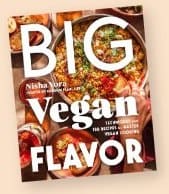




Is urad gota a suitable substitute for urad dal? AFAIK, it is black gram with the outer skin dehulled.
Sorry, I meant to comment on your Dal Makhani recipe. But my question remains :)
This has been a staple in my rotation for a few years now but I recently made a batch for my south Asian neighbor after her surgery. It got her seal of approval said it was very close to home! Thanks for the nourishing recipe ☺️
Aw, thanks so much for sharing that, Stella! :) We appreciate it and we are happy it won her stamp of approval.
This dish is perfect. It’s just bursting with flavor.
Thanks for the kind words, Jenean!
I always wanted to try this dal. I’m so glad that I chose this recipe to make my first batch. This was so flavorful and delicious. I ordered most of the ingredients that aren’t at my local grocery store off of Amazon. I will definitely make this again. I served it with sourdough flatbread
We’re over the moon to hear you enjoyed the recipe, Terry. Thanks for your kind words!
This was soo delicious. Thank you for sharing.
Awesome, Ally. Thanks for your comment and for taking the time to review!
I made the Dal Tadka today, I followed all the steps from the recipe and sticked to 2,5 cup of water and not more. I didn’t have curry leaves so I left that out and I didn’t have cumin seeds for the Tadka, so I used cuminpowder. I didnt have the special pepper so used chili flakes. I topped it up with plenty of cilantro, red onion slices and sesame seeds over the rice and it was a great success!
Awesome, Libro. Thanks for your comment and for taking the time to review!
I made this recently and it was fantastic!! I’m going to make it for my son and his family later this week. I’ll be visiting them in San Antonio and I’m excited to make this for them with some vegan naan.
Delicious!! No wonder this recipe is so popular! I added more cilantro and fresh mint after the tomatoes were done, then served with a lime yogurt sauce and pickled red onions. The mint really makes it sing. Thank you for another fantastic recipe!
We’re over the moon to hear you enjoyed the recipe, Pamela. Thanks for your kind words!
Hello. Wondering if next time I could add chickpeas along with the Dal?
Hi Hope, I’m sure you could stir some cooked chickpeas into the dal towards the end of cooking.
Would not recommend making this in the instant pot. I followed the recipe exactly as written, but it came out a soupy, mushy mess. Like porridge. I don’t know if I’m even willing to eat this. Really disappointed.
I made it on the stovetop before and it came out nicely. Instant pot is not the way to go for this dish. :(
This tastes exactly like what I used to eat from my favorite, amazing restaurant! I omit the chilies and the curry powder, and it is just the right, mild heat for me. I am so glad I found this recipe. It will be my figure go-to! Many thanks! 🙏🏼
So glad to hear that this recipe brings back those favorite restaurant flavors for you, Jenny! Love that you’ve found the perfect balance of heat to suit your taste. Thanks for sharing, and we hope this recipe remains a go-to for you! 😊🙏🏼
Went to my local Indian grocery store for this and was greatly rewarded! I used avocado oil and yellow split mung beans and it all worked out great! I did burn the tadka BC the oil got too hot before I added the spices so I would just warn about that to others to be careful… But still very yummy! Served with jasmine rice ! Thanks Nisha!
Hi Skye, we appreciate the review! Thanks for giving the dal tadka a shot :)
I can’t find the section of the recipe about what kind of lentils to use.
Hi Wendy, in the recipe card you can see Nisha calls for “1 cup (200g) split yellow lentils, aka ‘moong dal.'”
Enjoy!
Hi Nisha,
My cupboards are filled with herbs and spices for various cuisines: Indian; Thai; Euro; Mexican, etc. So, having taken the trouble (and expense) of acquiring all these ingredients, I always get a bit distressed when I read “curry powder” or “Italian herbs” or “chili powder” in a recipe. I always think these are so idiosyncratic and they change from one cook/household to another (I guess the same can be said for garam masala, but that’s in a different category), and I find the ones you can buy in the supermarket are frankly boring.
Anyway, since you’ve included the dreaded words “1 teaspoon curry powder” in your Dal Tadka recipe, I wonder if you have your own blend for curry powder. Have I missed it in another of your recipe collections? Would you mind sharing it with me/us?
Hi Stephen, we occasionally use curry powder to add a punch of flavor without having to add extra individual spices to a recipe. Here, we would replace it with ½ teaspoon ground cumin, ½ teaspoon ground coriander, and slightly more turmeric (a heaping ¼ tsp). Enjoy!
If I could upload a pic I would, this dish was abolutely heavenly! I told my East Indian girlfriend what I was making and said the “tadka ” wrong and she corrected me. It was so worth the effort.
Thank you so much
Thank you for your lovely comment! It makes us happy to know that you enjoyed the recipe. :)